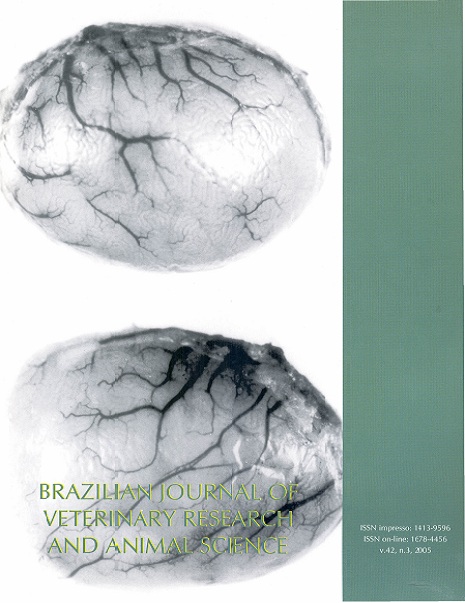Epidemiologic surveillance of the rabies virus using the brain immunoflorescence test on a sample of a canine population: probality and analysis with actual cases from Mogi-Guaçu, SP, Brazil, During the 1989-1999 period
DOI:
https://doi.org/10.11606/issn.1678-4456.bjvras.2005.26432Keywords:
Dog, Survillance, Rabies, Mogi-Guaçu, São Paulo (Estado)Abstract
The validty of a systematic laboratory exam that consists in examining the nervous system of a canine population sample in a given area was anlyzed, as a proper strategy for epidemiological survilance of the rabies virus presence. The analysis was based on the databank of the County of Mogi-Guaçu, SP, Brazil, referring to the historical period between January 1989 and december 1999. During this period 1,167 animals were examined and an immunofluorescence test applied to rabies showed that 130 animals (11.2%) were positive. The sample size for detecting at least one positive animal was calculated by using the formula n = {1-(1-±)1/d } (N - d/2} + 1. Between 1989 and 1994 the size of sample was calculated based on the real number of recorded cases. Between 1995 and 1999, as there were no new cases of canine rabies, the analysis considered a hypothetical presence of a confirmed case. It was also carried out a simulation of the number of rabies cases that should occur so that the sample effectively used by the Rabies Control Service would be able to reveal the presence of at least one positive animal. Results showed that in the period from 1989 to 1994, in when the annual frequecy of canine rabies cases varied from 5 to 75 cases, the ideal size of sample should be from 12,400 to 12,922. In the period from 1995 to 1999, when no canine rabies cases were recorded, the sample size would be from 13,257 to 14,698 if at least one case occurred. Thus, one can understand that in therms of probability, the proposed strategy is not recommended for the epidemiological survilance of rabies virus presence, since the number of animal to be examined is not feasible in real situation.Downloads
Downloads
Published
2005-06-01
Issue
Section
UNDEFINIED
License
The journal content is authorized under the Creative Commons BY-NC-SA license (summary of the license: https://
How to Cite
1.
Pinto H de BF, Miguel O, Assis A. Epidemiologic surveillance of the rabies virus using the brain immunoflorescence test on a sample of a canine population: probality and analysis with actual cases from Mogi-Guaçu, SP, Brazil, During the 1989-1999 period. Braz. J. Vet. Res. Anim. Sci. [Internet]. 2005 Jun. 1 [cited 2025 Apr. 3];42(3):196-203. Available from: https://revistas.usp.br/bjvras/article/view/26432





